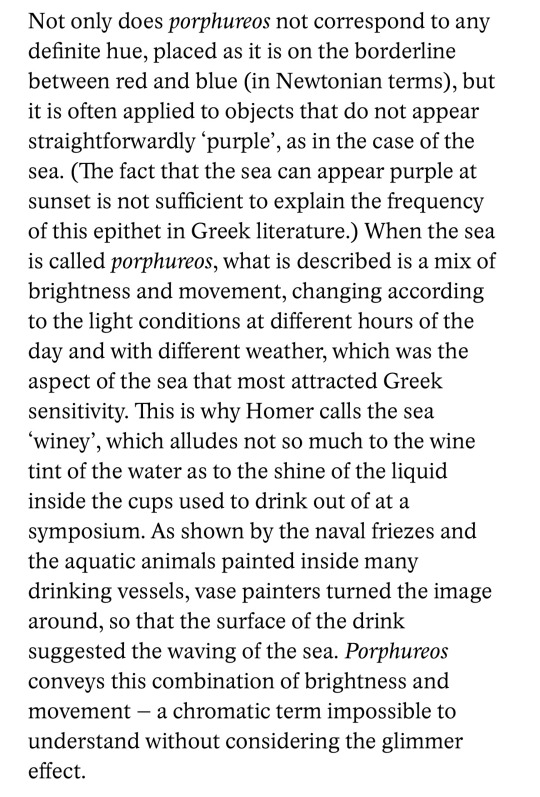#maria michela sassi
Text
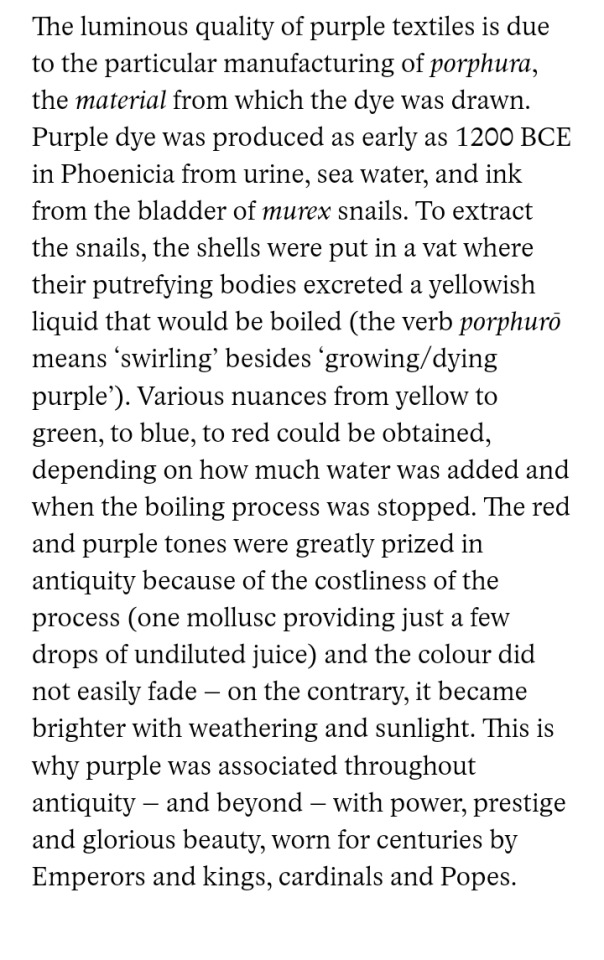
—Maria Michela Sassi, "Can we hope to understand how the Greeks saw their world?" (pub. Aeon) [ID in ALT]
7K notes
·
View notes
Note
what does your bio mean? "the sea was never blue" ?
Homer used two adjectives to describe aspects of the colour blue: kuaneos, to denote a dark shade of blue merging into black; and glaukos, to describe a sort of ‘blue-grey’, notably used in Athena’s epithet glaukopis, her ‘grey-gleaming eyes’. He describes the sky as big, starry, or of iron or bronze (because of its solid fixity). The tints of a rough sea range from ‘whitish’ (polios) and ‘blue-grey’ (glaukos) to deep blue and almost black (kuaneos, melas). The sea in its calm expanse is said to be ‘pansy-like’ (ioeides), ‘wine-like’ (oinops), or purple (porphureos). But whether sea or sky, it is never just ‘blue’. In fact, within the entirety of ancient Greek literature you cannot find a single pure blue sea or sky.
— The Sea Was Never Blue, Maria Michela Sassi
What, from a cursory glance, appears blue generally has more to say. You lift a precious stone to the sunlight and it lights up, it refracts, but there’s always a side you can’t see. If you think you’ve thought of it all, think a little longer. There’s always more to consider.
6K notes
·
View notes
Link
#found this article while working on the new chapter of read me#super fascinating stuff#ancient greeks and color theory
3 notes
·
View notes
Link
Color concepts | Mastering a mystery
1 note
·
View note
Link
Extremely cool article on the Ancient Greek Perception of colour
0 notes
Text
“Homer used two adjectives to describe aspects of the colour blue: kuaneos, to denote a dark shade of blue merging into black; and glaukos, to describe a sort of ‘blue-grey’, notably used in Athena’s epithet glaukopis, her ‘grey-gleaming eyes’. He describes the sky as big, starry, or of iron or bronze (because of its solid fixity). The tints of a rough sea range from ‘whitish’ (polios) and ‘blue-grey’ (glaukos) to deep blue and almost black (kuaneos, melas). The sea in its calm expanse is said to be ‘pansy-like’ (ioeides), ‘wine-like’ (oinops), or purple (porphureos). But whether sea or sky, it is never just ‘blue’. In fact, within the entirety of ancient Greek literature you cannot find a single pure blue sea or sky.”
— The Sea Was Never Blue, Maria Michela Sassi
0 notes
Text

—Maria Michela Sassi, "Can we hope to understand how the Greeks saw their world?" (pub. Aeon) [ID in ALT]
#love u for this anon ty#q#lit#quotes#essays#maria michela sassi#aeon#how the greeks saw colour#links#i dream in blue#m#x
3K notes
·
View notes
Photo

Homer used two adjectives to describe aspects of the colour blue: kuaneos, to denote a dark shade of blue merging into black; and glaukos, to describe a sort of ‘blue-grey’, notably used in Athena’s epithet glaukopis, her ‘grey-gleaming eyes’. He describes the sky as big, starry, or of iron or bronze (because of its solid fixity). The tints of a rough sea range from ‘whitish’ (polios) and ‘blue-grey’ (glaukos) to deep blue and almost black (kuaneos, melas). The sea in its calm expanse is said to be ‘pansy-like’ (ioeides), ‘wine-like’ (oinops), or purple (porphureos). But whether sea or sky, it is never just ‘blue’. In fact, within the entirety of ancient Greek literature you cannot find a single pure blue sea or sky. — The Sea Was Never Blue, Maria Michela Sassi What, from a cursory glance, appears blue generally has more to say. You lift a precious stone to the sunlight and it lights up, it refracts, but there’s always a side you can’t see. If you think you’ve thought of it all, think a little longer. There’s always more to consider. https://www.instagram.com/p/BzrBTPOjDRTCrho7bXsDcw_ovjvxRRjTIoMH-80/?igshid=13cfjqbfykanj
0 notes
Text
Tweeted
Can we hope to understand how the Greeks saw their world? – Maria Michela Sassi | Aeon Essays https://t.co/ZOC7jX5AZq http://pic.twitter.com/iWQdxiukE6
— Adnan Ariffin (@zephyrzap) December 8, 2017
0 notes
Text
Beauty
What was ‘beauty’? – Linguistically speaking, beauty has changed quite significantly from Anglo-Saxon times; in Old English to describe beauty one would use words such as ‘faeger’, ‘hiwbeorht’ and, ‘leoht’. All three of these refer to light, giving us an insight into cultural expectations in these times. ‘Faeger’ led to the antiquated and archaic, ‘fair’, ‘hiwbeorht’ when broken down alludes to a ‘bright hue’ and ‘leoht’ translates to light.
Light was a major influence in the ancient world and its prestige is noted by its relation and association to beauty. Taking a glance towards the Greeks, the world was received by them in a varying way to our modern sensibilities and this contrast takes root in the realm of colour. An intriguing essay by Maria Michela Sassi relates the Grecian perception of colour and utilises Munsell’s colour sphere and theories in her description of cultural variations in the significance of colour properties:
1. Hue
2. Value
3. Chroma
4. Saliency.
“…the Munsell model is useful in that it helps to demonstrate the remarkable Greek predilection for brightness, and the fact that the Greeks experienced colours in degrees of lightness and darkness...” (Sassi, 2017). The preference held by Greeks of lightness and darkness over hue translated to their art with simplistic and chromatic artistry being favoured and held in higher prestige. What is also interesting is the prestige of lasting hues – another aspect of colour which the Greeks considered – its longevity. Particular colours because of their rarity and the difficulty of obtaining or creating them gave them a higher prestige, Sassi notes both a purplish hue and of course gold. This status given to specific colours meant they were favoured by royalty and nobility of both state and church.
The Greek perspective of colour is intriguing in its simplicity, essentially, they take the parts of colour and the experience of colour and value them, name them and write of them. They disregard the specificity of hue but rather isolate the traits of colour and colour experience – the swirling of purple dye, the wash of waves and how colour interacts with light, scenario and person. It is truly fascinating to perceive colour and the world in this way, it gives an alternative perspective to visual events we experience daily – we admire blue skies but why don’t we admire the way the clouds merge with the sky and how the sun mingles and interferes with the two. The importance of instance and memory is clearly a factor in this ideology.
I think the importance of memory and instance is a significant note; beauty has the same factors, and this relates to my previous post and ideas on time and beauty. There is a spontaneity and a momentariness to beauty, it requires the right scenario, the right person(s) and the right light. The relationship between colour, light and beauty is a longstanding companionship especially given the importance of the visual with beauty.
However, not all beauty is visual. Consider a visually impaired or blind person – can they experience beauty or are they inherently deprived due to their inability to see or see well? I watched several videos and a few participants, both blind, noted that ‘beauty is an experience’ and there are certain experiences that are beautiful and there are many aspects to a beautiful experience besides the visual. One must consider other senses; smell, touch, taste… sight is not the only aesthetic sense or beauty receptor. Beauty as an abstract idea is not inherently tangible, visible, audible or odorous, it is most simply an idea, a notion and a concept. The unreality of beauty is the root to the unanswerable question of what it is – it is so subjective and so discursive and therefore so immersive and inviting – beauty entices, intrigues and mystifies, and thus we cannot stop ourselves from wandering down the dark unlit alleys of our minds in search of what beauty is to us, to our community, our society and our world, what it did mean in the past and what it will mean in the future.
Alicia Dale
Sassi, Maria Michela; 2017: https://aeon.co/essays/can-we-hope-to-understand-how-the-greeks-saw-their-world
Boldly, How The Blind See Beauty: https://www.youtube.com/watch?v=hlcx_q8u_YI
Cut, Blind People Describe Beauty: https://www.youtube.com/watch?v=JO7X9ZPoAp8
0 notes
Text
Can we hope to understand how the Greeks saw their world? – Maria Michela Sassi | Aeon Essays
See on Scoop.it - Informática Educativa y TIC
The Greek colour experience was made of movement and shimmer. Can we ever glimpse what they saw when gazing out to sea?
0 notes
Text
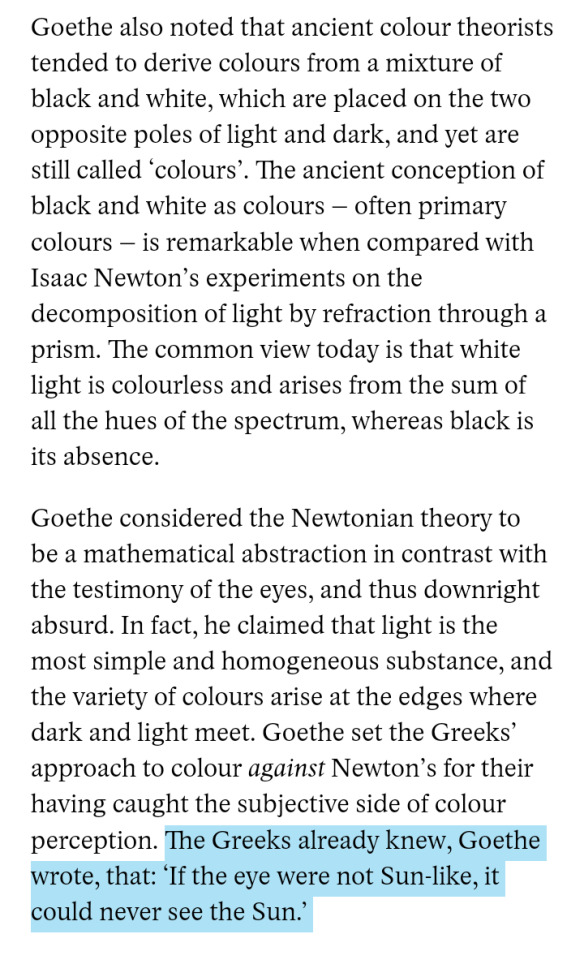
—Maria Michela Sassi, "Can we hope to understand how the Greeks saw their world?" (pub. Aeon) [ID in ALT]
1K notes
·
View notes
Text
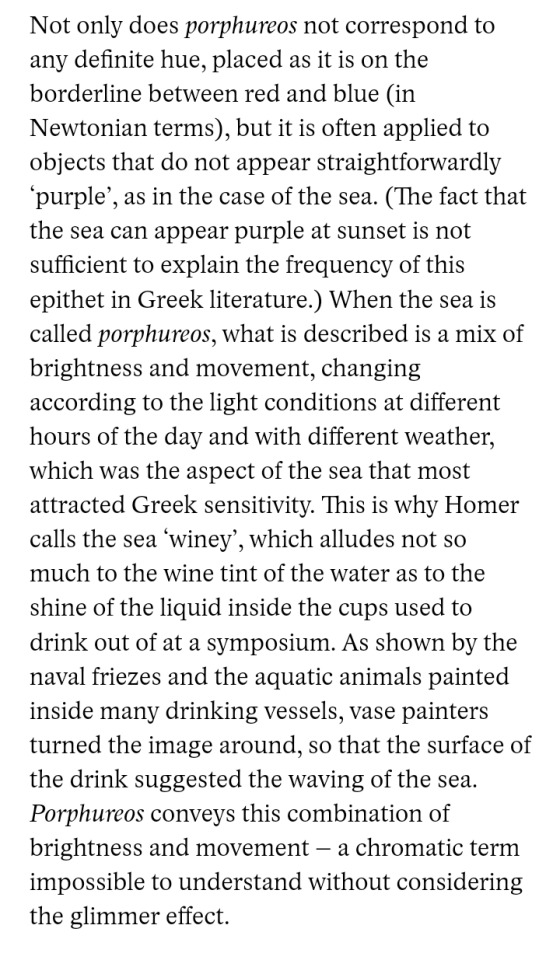
—Maria Michela Sassi, "Can we hope to understand how the Greeks saw their world?" (pub. Aeon) [ID in ALT]
#q#lit#quotes#articles#maria michela sassi#aeon#how the greeks saw colour#i dream in blue#oh shiny archive#m#x
499 notes
·
View notes
Text
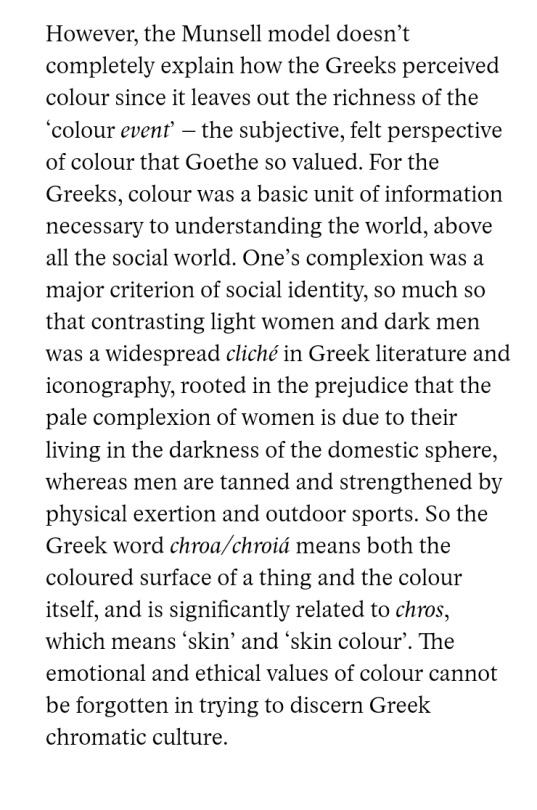
—Maria Michela Sassi, "Can we hope to understand how the Greeks saw their world?" (pub. Aeon) [ID in ALT]
198 notes
·
View notes
